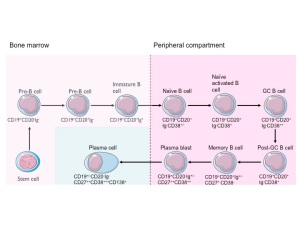Immune cells are distinguished from one another by the expression of different surface markers also know as “clusters of differentiation“or CD. These CDs help us identify the immune cell type (e.g. if it is a B cell, T cell, dendritic cell, macrophage etc.) and also which stage of differentiation the immune cell is in. Henceforth, one can distinguish their different sub-types. B cells are usually identified by their expression of surface marker CD19. This is also known as the general B cell marker on the surface of B cells from the pro B cell stage until the activation stage where it is expressed on both short- and long-lived plasma cells. Another common B cell marker is CD20, also expressed early in B cell development when the B cell reaches the “immature” stage before it exits the bone marrow. Hence, CD20 is expressed from the “immature” B cell stage of development up until memory B cell formation and is absent on antibody secreting plasma cells. CD27 is present on memory B cells, plasma blasts and plasma cells. CD38 is expressed when reaching the plasma blast stage of development and is also present on the short-lived subset of plasma cells, yet becomes downregulated when these develop into long-lived plasma cells. The general plasma cell marker is CD138, present on both short- and long-lived antibody secreting plasma cells, and is therefore absent on plasma blasts. Figure was produced using Servier Medical Art and adapted from Edwards and Cambridge, Nature Reviews Immunology 2006.
Now you see me… and now you don’t! B cell differentiation and surface marker expression
03 Thursday Jul 2014
Posted in Immunology

